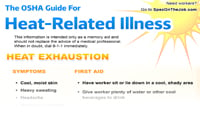
Download the Heat-Related Illness Flyer (PDF)
Summer weather is here. Because summer is the busiest time of the year for construction companies, both site supervisors and workers need to know the signs of heat exhaustion and heat stroke so that everyone can stay safe on the job.
Summer Heat Can Be Fatal
Thousands of workers across the U.S. suffer from serious heat-related illnesses every year.
According to the Centers for Disease Control and Prevention, an average of 600 people in the U.S. die from complications related to extreme heat every year. This is more than tornadoes, hurricanes, flooding, lightning or any other weather event combined.
Construction isn’t the only industry where workers need to take extra care. Agricultural workers, baggage handlers, landscapers, and anyone else who does work outdoors is at risk.
Know The Symptoms
Heat exhaustion is a precursor to heat stroke. It’s identifiable by heavy sweating, rapid pulse, dizziness, fatigue, cool, moist skin with goose bumps when in the heat, muscle cramps, nausea and headache.
Heat exhaustion can become heat stroke, which is the most severe form of heat-related illness. It results when your body temperature rises to 104 degrees Fahrenheit or higher. And without emergency treatment, it can lead to death – heat stroke has killed an average of 30 workers every year since 2003.

Heat Exhaustion Resources
Under OSHA law, employers are responsible for providing workplaces “free of known safety hazards.” Here’s what site supervisors can do to protect workers from heat exhaustion:
- Provide workers with water, rest and shade
- Allow new or returning workers to gradually increase workloads and take more frequent breaks as they build a tolerance for working in the heat
- Plan for emergencies and train workers on prevention
- Monitor workers for signs of illness.
OSHA also provides additional resources for employers on how to keep workers safe from the heat.


“Helping our clients get jobs done since 1998.”